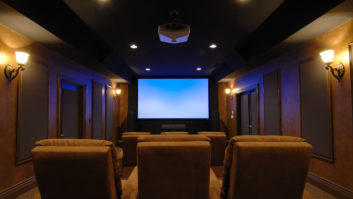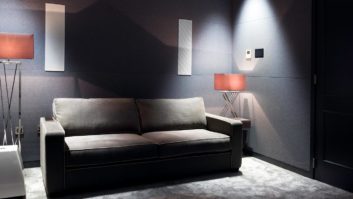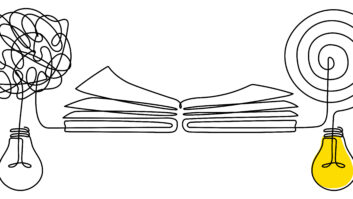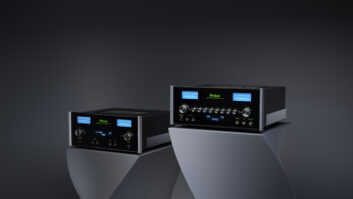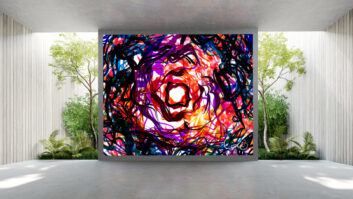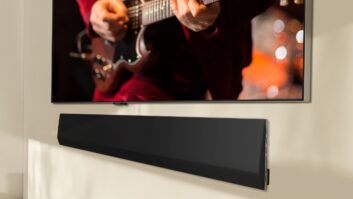Sometimes it really pays to take that final cruise around the exhibition floor. It certainly did for Chris Underschultz, the 36-year old owner of AV Works Inc., a three-year old Edmonton, Alberta, systems integration company working mainly in the high-end residential sector.
On the last day of CEDIA EXPO 2011, as he prepared to exit the Indiana Convention Center, Underschultz stumbled upon iRoom, the Salzburg, Austria, manufacturer of motorized in-wall iPad docks, new to the North American market. The encounter led to the inclusion of five iRoom docks in an AV Works project for a contemporary show home by Cami Custom Homes. The $3 million, 5,200-square-foot Edmonton home of acrylic stucco and stone also features Schneider Electric C-Bus lighting, an RTI control system, automated shade control, and Niles loudspeakers. The AV budget for the show home was about $140,000


The 17 x 34-foot theater was designed by Paradise Theater with an aesthetic meant to reflect the home’s overall architecture. Through the RTI control system, with iPad interface, users can control lights, sound, and action from any seat in the house.and an additional $238,000 for the dedicated theater.
With three floors, there is plenty to see above ground in the show home, including a multi-system main floor great room featuring a 55-inch flat-panel with Leon sou
ndbar and subwoofer.

“One of my favorite spots is the great room, Underschultz said. “When people enter, they hit an entertain button to dim the fireplace and turn on lights and music. They’re always impressed that touching only one button can set the mood. We concealed the in-wall sub, going with Leon to keep a clean unobtrusive look to the house. The less you see the better, except for iPads.”
A trip to the lower level theater has garnered rave reviews by those touring the show home, Underschultz said. “We decided on a dedicated theater, but we didn’t want it to be some rarely used dark room in the corner of the basement. We wanted an acoustically engineered space for entertaining friends, a place where you also could just go to read a book and relax.”Two gas fireplaces, in the great room and master suite, are controlled by iPads. The master also features a wall-mounted flat-panel and iPad control that includes a view from a front door security camera. A goodnight button controls lights throughout. The master bath features a very large tiled shower with a special touch: in-ceiling LED lighting and a 7-inch Niles stereo input speaker mimic a thunderstorm complete with rainfall.
The Theater Design
Enter Sam Cavitt, president of Paradise Theater, in Maui, HI. The theater, he said, was engineered for optimum performance, and the interior was designed to integrate with that performance. “The design mandate was to create an impressive enough room for potential clients to take notice and to see that a theater can be cost effective for them, too.”
Cavitt’s approach, to create a significantly betterthan- the-usual theater built on a budget marketable for the Edmonton area, drew inspiration from his past customized designs. “This was not a kit; it’s a custom fit for that unique space, the best of both worlds,” he said. “It’s cost effective with all benefits of a truly custom room.”
The 17 x 34-foot theater was designed by Paradise Theater with an aesthetic meant to reflect the home’s overall architecture. Accommodating at least 10 people, the room is furnished with a modern sectional and four theater seats. A standup bar is integrated into the back of the room.
AV works provided acoustical treatments and paneling throughout. This acoustical chassis includes decoupled construction for isolation and smooth bass response as well as interior acoustical treatment that resulted from precise modeling and analysis to provide balanced sound at all listening positions.
Through the RTI control system, with iPad interface, users can control lights, sound, and action from any seat in the house. LED lights in the soffits offer multiple color scenes simply controlled from the touchscreen.
“We appreciate the versatility and flexibility of the RTI system,” Underschultz said. “We can create anything we want with it, and there are a lot of third-party drivers available. Integrating with other devices is becoming easier. It’s a product we can hit with almost any price point. And it’s expandable and scalable.”

Two gas fireplaces, in the show home’s great room and master suite, are controlled by iPads. The design also features Schneider Electric C-Bus lighting, an RTI control system, automated shade control, and Niles loudspeakers.The theater’s Niles StageFront speakers perform optimally in the accurate acoustical environment. “The StageFront series is a flagship for us,” Underschultz said. “Niles made it lucrative for us in this project, and they helped us out with pricing because we’re a dealer and this is a show home for a new builder. They worked with us hand in hand.”
The theater features a Mitsubishi HC9000 1080p/3D projector and a Screen Innovations 120-inch screen acoustically transparent woven screen. “We wanted a center speaker mount installed behind the screen,” Underschultz explained, “so we needed a screen that audio could pass through.
Because ceiling heights were limited and numerous subsystems and structural elements were located in joist bays, a precise design was needed. The lighting design was configured to offer multiple zones to support various scenarios while maintaining light control at the screen to preserve picture quality.
“The theater ceiling was full of mechanical [elements],” Underschultz said. “All three floors have in-floor heating, and a heating run ran alongside the mounted projector. We compensated by modifying soffits and we extended the bulkhead a little farther.”
The Earlier the Better

The AV Works team: (l-r) Chris Underschultz, Mike Englberger, Mike Newton, Heather Chenard, and Vladimir Socaciu.AV Works came into the show home project as the house it was being built. Getting in early was the key to a successful result for the integrator. “If you come in later the other trades can get in the way,” Underschultz noted. “All the trades involved in this project were accommodating and had passion for it.”
Working on a show home installation has a different sensibility than a typical residential project, of course. For example AV Works wanted to accentuate every system function and detail. “For an individual client, you tailor the system to work with what that client wants in a particular location. Here, we wanted to highlight everything possible, pushing the limits and adding extras. We spent quite a bit more time in the programming and design phase,” Underschultz said.

The AV budget for the show home was about $140,000 and an additional $238,000 for the dedicated theater.His company is unique, he said, as it does in-house programming and inhouse design in 3D CAD. “A potential customer who had already met with another integrator came through the show home, and after I demonstrated how we could choose colors, lighting, and furniture with CAD, he liked the fit and finish of our end result so much he hired us to work on his house.”
Mid to high-end new home construction in the Edmonton area has remained strong, according to Undershultz. And the publicity from this show home project has opened doors for his company. “We’ve grown 35 to 40 percent in each of our three years in business and will this year as well,” he said. “I’ve seen a gap in our market in that a lot of companies are doing the same thing over and over in AV design. We spent the budget for this show home theater where it was most important. Room construction and layout are as important as product.”
Theaters were losing popularity as clients had a hard time justifying cost for the space, Underschultz said. But his goal is to alter that mentality. “We’re changing people’s thoughts on what a theater room is with this show home,” he explained. “We’ve shown them that it can be a space used every day.”
Karen Mitchell is a freelance writer based in Boulder, CO.
